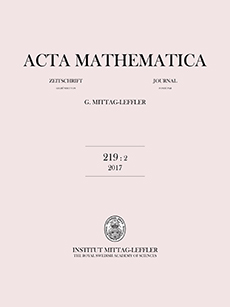Abstract
In this article, we prove the mean-convex neighborhood conjecture for the mean-curvature flow of surfaces in $\mathbb{R}^3$. Namely, if the flow has a spherical or cylindrical singularity at a space-time point $X=(x, t)$, then there exists a positive $\varepsilon = \varepsilon (X) \gt 0$ such that the flow is mean convex in a space-time neighborhood of size $\varepsilon$ around $X$. The major difficulty is to promote the infinitesimal information about the singularity to a conclusion of macroscopic size. In fact, we prove a more general classification result for all ancient low-entropy flows that arise as potential limit flows near $X$. Namely, we prove that any ancient, unitregular, cyclic, integral Brakke flow in $\mathbb{R}^3$ with entropy at most $\sqrt{2 \pi / e + \delta}$ is either a flat plane, a round shrinking sphere, a round shrinking cylinder, a translating bowl soliton, or an ancient oval. As an application, we prove the uniqueness conjecture for meancurvature flow through spherical or cylindrical singularities. In particular, assuming Ilmanen’s multiplicity‑$1$ conjecture, we conclude that for embedded $2$‑spheres the meancurvature flow through singularities is well-posed.
Citation
Kyeongsu Choi. Robert Haslhofer. Or Hershkovits. "Ancient low-entropy flows, mean-convex neighborhoods, and uniqueness." Acta Math. 228 (2) 217 - 301, June 2022. https://doi.org/10.4310/ACTA.2022.v228.n2.a1
Information





